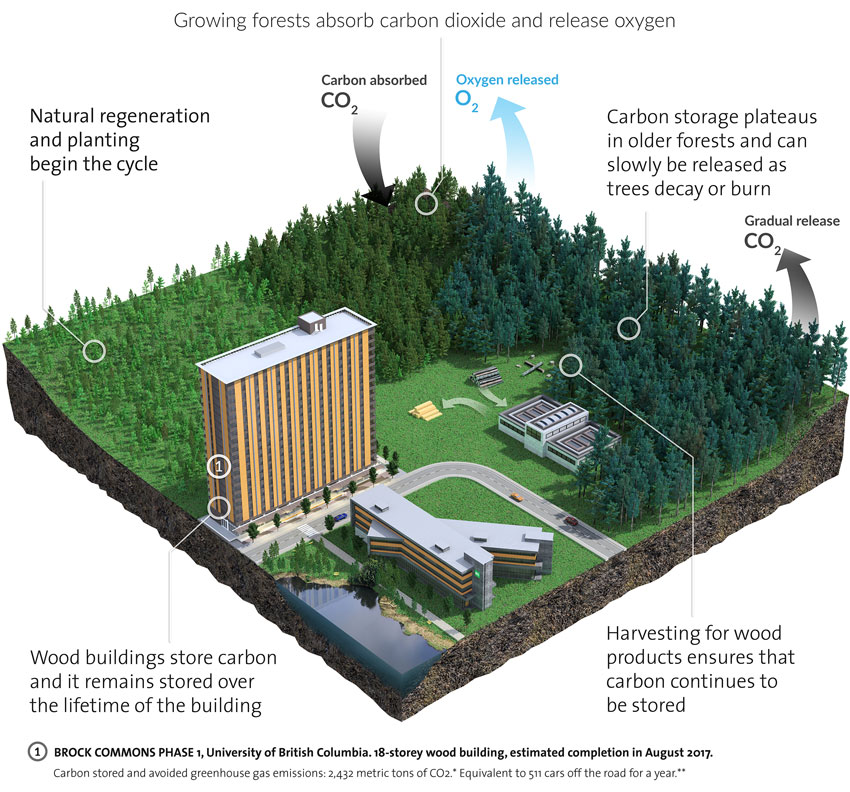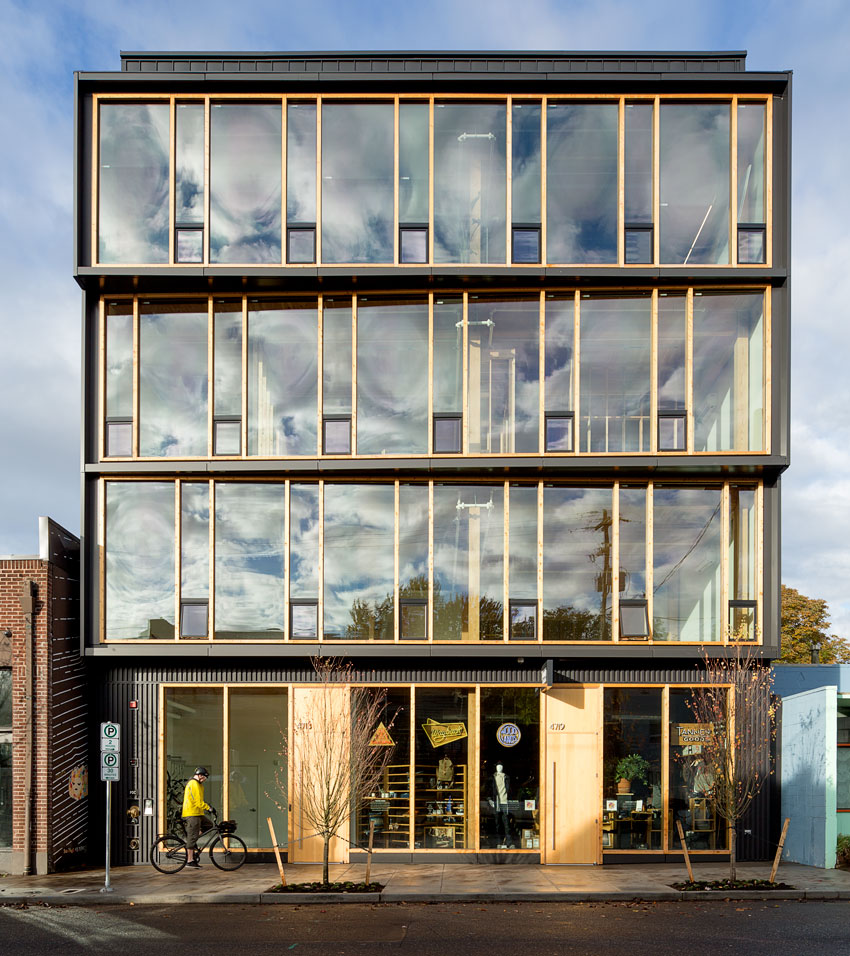Structural Wood Building Systems
Light-Frame Applications
Wood is increasingly being used in midrise buildings due to its durability and low cost relative to other material options. In fact, the International Building Code (IBC) permits up to six stories of wood-framed construction depending on building type (five for affordable, military, multifamily, senior, and student housing, and six for certain types of commercial structures). Additionally, the use of concrete-and-steel podiums allows light-frame construction to be used to create even taller buildings, with the podium and wood structures treated separately and divided by a horizontal fire-rated assembly.
Updates in the 2015 IBC allow for multistory podiums, which makes it easier for architects to use wood to effectively and economically capitalize on the growing demand for high-density, mixed-use structures featuring office or multifamily residential space atop ground-level retail and dining. Grocery-anchored residential developments are particularly popular today and can benefit from the ability to erect multiple stories of wood-framed construction atop a one- or two-story concrete or masonry podium. Note that previous versions of the IBC require exemptions from local authorities in order to build more than a single-level podium, and those may still be required in jurisdictions following earlier versions of the code.
Project teams seeking a more environmentally friendly structure are designing their podiums out of wood too. Buildings with wood podiums have a lower mass, meaning less material is needed for the foundation and shear walls. Consistent structural material use throughout the building also reduces the need for different trades on-site, streamlining labor costs and construction timelines.
Light-frame systems are typical in Type V and Type III construction and are described in IBC sections 602.3 and 602.5 respectively. Chapter 23 of the 2012 IBC covers general guidelines for structural wood products and the associated minimum design requirements. This chapter offers an overview of wood design and references these American Wood Council publications:
- The National Design Specification® (NDS®) for Wood Construction includes design equations and properties for most wood products, systems, and connections. It is supplemented by design examples and commentary.
- Special Design Provisions for Wind and Seismic contains information on lateral-force-resisting system design, including design methods, equations, and system capacities.
- The 2012 Wood-Frame Construction Manual (WFCM) for One- and Two-Family Dwellings includes tabulated engineered and prescriptive design and construction provisions for connections, wall systems, floor systems, and roof systems based on the specific loads from ASCE 7-10: Minimum Design Loads for Buildings and Other Structures.

Photo courtesy of Ema Peter
T3 | Michael Green Architects + DLR Group
For office, mixed-use, multifamily, or hospitality environments, the aesthetic of mass timber can be a particular draw, resulting in higher rents and longer-term tenants.
Mass-Timber Applications
Because of its strength and dimensional stability, mass timber offers a low-carbon alternative to steel, concrete, and masonry for many applications and is typically used in Type IV construction. A complement to other wood-framing systems, it can be used on its own, in conjunction with other wood systems such as post and beam, or in hybrid structures with steel or concrete. Mass timber is not necessarily a good substitute for light-wood-frame construction only because dimension lumber framing offers such a compelling combination of performance and cost where permitted by code. For this reason, building types where designers typically default to forms of construction other than light-frame—including offices, schools, public and institutional buildings, and taller mixed-use occupancies—may offer greater appeal for mass timber than low-rise commercial or residential buildings, although examples of the latter do exist.
For office, mixed-use, multifamily, or hospitality environments, the aesthetic of mass-timber can be a particular draw, resulting in higher rents and longer-term tenants. Mass timber has a number of characteristics that make it attractive for schools and universities as well. These include, for example, the ability to construct an entire project over the summer while students are off campus, the potential efficiencies of replicable modular designs, a lighter carbon footprint, and the positive impacts of exposed wood on student well-being. As the construction industry, accustomed to building institutional buildings such as schools using conventional wall, roof, and floor assemblies, gains more experience with these versatile new timber products, greater production economies will accrue, and more of timber’s potential benefits such as light weight, high strength, and workability will be captured.
Reasons to use mass timber in public and institutional buildings are similar to those for offices and schools, including a smaller carbon footprint and wood’s biophilic effects. The aesthetic possibilities are also exciting to many designers. With a growing body of research supporting the positive impacts of wood on occupant well-being, there is also a trend toward the use of mass timber in healing environments.
Taller Mixed-Use Occupancies
While most of this course focuses on structures that can be built under current U.S. building codes, a discussion of mass-timber is incomplete without reference to wood high-rises. Many examples exist worldwide, illustrating the potential of mass timber to bring environmental and other advantages to higher-density projects. In the United States, a number of tall-wood buildings are in design, including the winners of the U.S. Tall Wood Building Prize Competition. A tall wood building is a minimum of 80 feet in height.

Taller wood projects are a reality, with more developers and architects opting for mass timber as a sustainable solution to attain safe, cost-effective, high-performing buildings in urban-dense settings.

Wood structural systems are fully capable of meeting a nonresidential building’s longevity expectations. Wood should be considered a preferred material because it enables easy building modification in response to changing needs and materials are easy to recover when a building is decommissioned.
Established by the U.S. Department of Agriculture (USDA), Softwood Lumber Board (SLB) and Binational Softwood Lumber Council (BSLC), the competition was the first step in a process to showcase the safe application, practicality, and sustainability of tall-wood structures using mass timber, composite wood technologies, and innovative building techniques. Given that wood buildings over six stories are not currently within the prescriptive height limits of the IBC, designers of taller projects must follow an alternative-means process in consultation with the authority having jurisdiction over appeal of the building project. However, the International Code Council (ICC) Board of Directors recently approved the formation of a Tall Wood Ad Hoc Committee. Comprising stakeholders, code officials, and other interested parties, the committee will study tall-wood construction, and its findings may contribute to code changes for the 2021 IBC.
Why Build with Wood?
Sustainability: Carbon Footprint, Long Life Cycle, and Resiliency
Wood building products allow the use of a renewable and sustainable resources as an alternative to more fossil-fuel-intensive materials, resulting in a reduced carbon footprint. Designers of tall-wood buildings have been especially focused on the reduced carbon footprint achieved by using wood, which aligns with the goals of Architecture 2030. Reducing carbon is also a priority for many public buildings and schools.

Photo courtesy of LEVER Architecture
Albina Yard | Lever Architecture
Left exposed, visible wood structural elements offer impressive visuals that accentuate a project’s design and improve occupant health and well-being.
In addition, wood buildings are very durable and resilient in cases of seismic or high-wind events. The world is full of examples of ancient wood-frame buildings that remain structurally sound. In fact, extended service life is one of the key advantages wood offers as a nonresidential building material. With proper design and construction, wood-frame buildings resist damage from moisture, insects, and other organisms and provide decades of service equivalent to other building types.
There are many applications where the natural durability properties of wood make it the material of choice. For example, wood is resistant to high relative humidity and many of the chemicals and conditions that adversely affect steel and concrete, such as corrosive salts, dilute acids, industrial stack gases, and sea air. Because of its resistance to these factors, building professionals often use wood for specific nonresidential structural applications, such as cooling towers and industrial buildings used for chemical storage.
Quality assurance and proper maintenance are key to ensuring that wood structures will provide the service life desired. There are recommended methods to protect wood-frame structures against durability hazards and thus provide maximum service life for the building. All require proper design and construction, including moisture control, termite and other pest control, durable materials, and quality assurance during design and construction as well as through a building’s service life using appropriate maintenance practices.
Wood structural systems are fully capable of meeting a nonresidential building’s longevity expectations. Wood should be considered a preferred material because it enables easy building modification in response to changing needs. Additionally, wood materials are easy to recover when a building is decommissioned.
Construction Efficiency
Wood can be a suitable replacement in applications that use concrete, masonry, and steel and is frequently quicker and easier to erect, especially in tight job sites. Light-frame and mass-timber construction are fast, and speed correlates to revenue, whether the project is an office, school, student residence, condominium, or hotel. Bernhard Gafner, formerly of structural engineering firm Fast + Epp, says, "A mass-timber project is approximately 25 percent faster to construct than a similar project in concrete." Noting the advantages for urban infill sites in particular, he says it also offers 90 percent less construction traffic (trucks delivering materials) and requires 75 percent fewer workers on the active deck, making for a much quieter job site.
The fact that wood weighs less than other materials also has a number of potential benefits, including smaller foundation requirements and lower forces for seismic resistance. Because mass timber is lighter than steel and concrete, it can be a good solution for sites where poor soil is an issue. There is also a trend toward the integration of services into prefabricated elements, such as panels and trusses.
Occupant Well-Being and Aesthetics
An increasing number of studies focused on wood’s biophilic aspects have linked the use of exposed wood in buildings with improved occupant health and well-being. Left exposed, visible wood structural elements offer impressive visuals that accentuate a project’s design. Modern wood products bring warmth and beauty to the interior while promoting a healthy environment.









